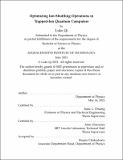Optimizing Ion-Shuttling Operations in Trapped-Ion Quantum Computers
Author(s)
Qi, Luke
DownloadThesis PDF (18.48Mb)
Advisor
Chuang, Isaac L.
Terms of use
Metadata
Show full item recordAbstract
Trapped ions are a promising candidate for quantum computation. As experiments with ions increase in size and complexity, a trap array-based architecture for an ion trap with many independent zones provides a path towards large-scale integration. A crucial element in the operation of a trap array is the ability to split, move and recombine chains of ions on diabatic timescales and without incurring excessive decoherence of information stored in ion qubits. In this thesis, I investigate whether ion transport and splitting can be realistically integrated in the future quantum processor and what the requirements are to achieve this.
I discuss my end-to-end numerical simulation pipeline of the ion shuttling process. Using these simulation tools, I investigate the leading theories for ion transport and splitting, based on Shortcuts-to-Adiabaticity principles, and extend these methods into two central criteria for optimal ion shuttling. I present a novel method for optimizing the voltage controls to achieve optimal ion shuttling, that use accurate models of the digital-to-analog converters, amplifiers, and low-pass filters of our ion trapping system.
I demonstrate fast and robust transport of 40Ca on our custom-designed surface electrode trap and share spectroscopy data taken during the first ever attempt at optimal splitting. I then outline the necessary steps to achieve fast splitting with less than 1 quanta of excitation. It is my hope that the theories, software, and experimental results presented in this thesis demonstrate the feasibility of optimal ion transport and splitting in state-of-the-art, scalabale surface traps and become a standard for future ion shuttling experiments.
Date issued
2021-06Department
Massachusetts Institute of Technology. Department of PhysicsPublisher
Massachusetts Institute of Technology